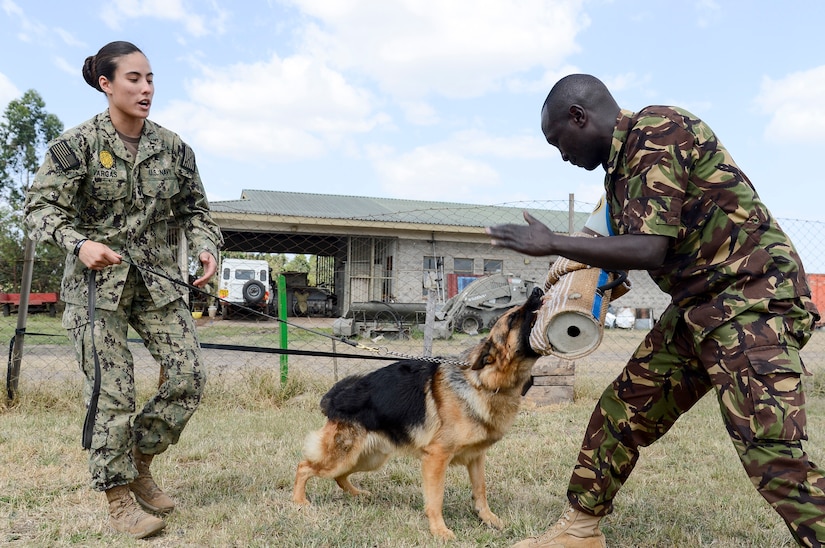By Navy Petty Officer 2nd Class Timothy M. Ahearn, Combined
Joint Task Force Horn of Africa
NAIROBI, Kenya -- Kenyan and American service members teamed
up at the Kenyan army’s 1st Canine Regiment headquarters here to share the best
ways to treat and train military working dogs in the field, Aug. 6-10.
A U.S. Army veterinary team assigned to Combined Joint Task
Force Horn of Africa’s 404th Civil Affairs Battalion’s Functional Specialty
Team and a U.S. Navy military working dog kennel master based at Camp
Lemonnier, Djibouti, took part in the training.
Founded in 2012, the 1st Canine Regiment’s mission is to
provide dogs as a force multiplier in war and peacetime in order to address the
current threat of asymmetric warfare. To that end, they specialize in explosive
detection, patrolling, road and building clearance, and search and rescue, said
Kenyan army Maj. Marion Amulyoto, a veterinarian with the 1st Canine Regiment.
Dangerous Work
“We have been a valuable resource to our commanders,
especially along the borders,” Amulyoto said. “Our explosive detection dogs
deter violent extremists, because they are able to pick up on residual odors
from explosives.”
This mission often brings dogs and their handlers to the
Kenya-Somalia border to deter transnational threats, such as poachers, and
violent extremist organizations, said U.S. Army Maj. Steven Pelham, the
veterinarian officer in charge with the 404th Civil Affairs Battalion FXSP.
The FXSP veterinarians’ portion of the exchange included
information on bandaging, wound care, heat stroke, canine CPR, fractures and
suturing. The 1st Canine Regiment veterinarians shared their knowledge of the
dangers the dogs face, specifically in East Africa.
“Heat injuries and threats from wildlife our dogs do not
normally encounter, such as snakes, spiders and scorpions, are likely, given
the environment that the U.S. and Kenyan MWDs operate in East Africa,” Pelham
said, “We want to ensure that all MWD handlers recognize and treat their
partners in case they suffer from these injuries.”
This exchange also marked the first time that members of the
1st Canine Regiment could share knowledge with a U.S. Navy dog handler.
Common Ground
“I am really excited to work with the 1st Canine Regiment’s
MWD handlers; to share working knowledge with our Kenyan partners is an amazing
opportunity,” said Navy Petty Officer 1st Class Kristina Vargas, a master-at-arms
and Camp Lemonnier’s kennel master.
While learning the various techniques that the 1st Canine
Regiment uses in their daily operations, Vargas shared knowledge of basic
explosive detection, patrolling, building clearing, and improvised explosive device
recognition.
Vargas said it is easy to find common ground among military
working dog handlers, regardless of what nations the handlers are from.
“When you get MWD handlers together, regardless of their
branch of service, or even if they are from another country, at the end of the
day we are all dog handlers helping out dog handlers, we share the same passion
for our respective MWD programs,” she said.
Kenya is the only country in East Africa with a canine unit
organic to its military. Learning from one another helps both the 1st Canine
Regiment and CJTF-HOA to maintain security and stability in their shared area
of operations.
“We are very grateful to CJTF-HOA for this exchange program
and we hope to have more in the future to better both of our capabilities,”
Amulyoto said.
Vargas said the exchange strengthened the relationship with
a key East African partner. The Kenyan dog handlers can incorporate the
training into their existing working dog program to help counter threats from
violent extremists and promote national and regional security.









No comments:
Post a Comment